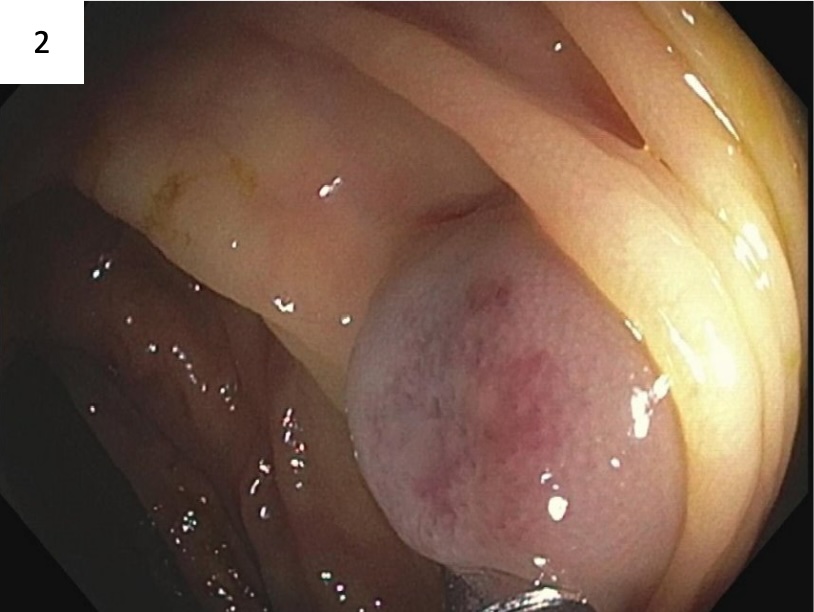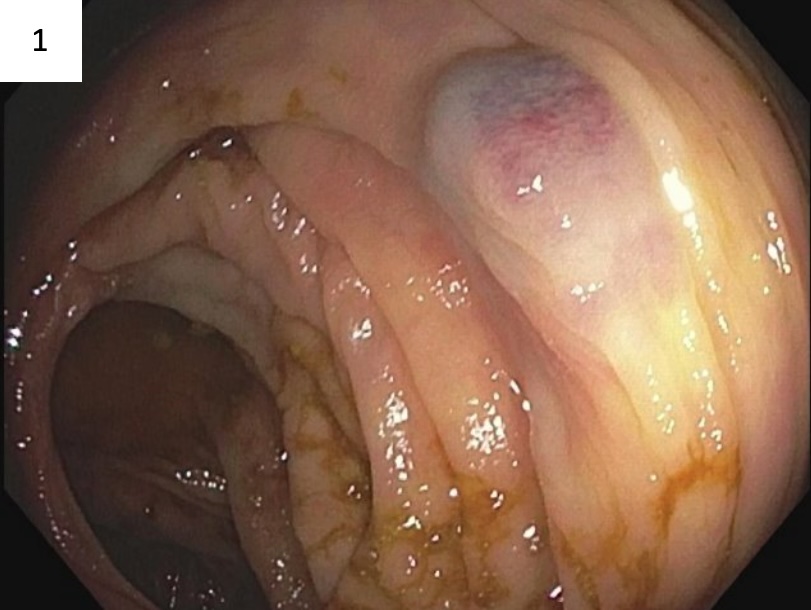Tuesday Poster Session
Category: GI Bleeding
P5268 - Severe Anemia as a Complication of Blue Rubber Bleb Nevus Syndrome
Tuesday, October 28, 2025
10:30 AM - 4:00 PM PDT
Location: Exhibit Hall

Matthew Posen, DO
Advocate Christ Medical Center
Oak Lawn, IL
Presenting Author(s)
Matthew Posen, DO1, Kamakshi Katwala, MD2, Krishna Shah, MD1, Ruben Martinez, MD1, Regine Lim, DO2, Tarek Almouradi, MD1
1Advocate Christ Medical Center, Oak Lawn, IL; 2Advocate Christ Medical Center, Chicago, IL
Introduction: Blue rubber bleb nevus syndrome (BRBNS) is a rare congenital condition characterized by venous malformations (VMs) primarily of the cutaneous and gastrointestinal systems. Below, we present a typical case presentation and common complication from gastrointestinal VMs causing severe anemia.
Case Description/
Methods: A 20-year-old male with history of blue rubber bleb nevus syndrome presented to the hospital for severe anemia with hemoglobin of 3.3g/dL found on outpatient labs as well as six-weeks of bright red blood per rectum. Three units of packed red blood cells were transfused with improvement to a hemoglobin of 7.2g/dL. Other lab results included mean corpuscular volume of 64.7fL, iron of 10mcg/dL, percent iron saturation of 2%, and total iron binding capacity of 401mcg/dL and the patient was started on intravenous iron sucrose. Esophagogastroduodenoscopy revealed a VM of the tongue. Colonoscopy revealed three non-bleeding VMs in the ascending, transverse, and sigmoid colon. As the VMs were non-bleeding, no acute intervention was performed. The patient’s hemoglobin remained stable, and he was discharged on oral iron supplementation and proton pump inhibitors with plan for follow up with genetic specialists for BRBNS.
Discussion: Approximately 30% of BRBNS cases are diagnosed at birth; however, 10% of cases are estimated to be diagnosed in adolescence or later. This is most often a result of delayed onset of angiogenesis or can be attributed to non-cutaneous VMs that are not clear on physical exam. With patients that do not present with cutaneous VMs, diagnosis can be delayed until iron deficiency anemia or severe gastrointestinal bleeding arises. Some patients present with intussusception as VMs can cause a nidus for telescoping of the bowel. BRBNS treatment is tailored to patient presentation, with most presentations requiring symptomatic management. As with typical VMs, patients with significant bleeding are treated with sclerotherapy and band ligation. Serious or refractory cases may undergo partial gastrointestinal resection. Pharmacologic agents have shown mixed response with some promise in treatment with Sirolimus to prevent angiogenesis and new VMs to decrease blood transfusion frequency. In patients with conditions predisposing them to complications such as bleeding, physicians must take the prerogative to properly inform their patients of alarming symptoms to reduce loss to follow up and severe complications.

Figure: Image 1: Endoscopic visualization of venous malformation in the ascending colon.

Figure: Image 2: Endoscopic visualization of venous malformation in the transverse colon.
Disclosures:
Matthew Posen indicated no relevant financial relationships.
Kamakshi Katwala indicated no relevant financial relationships.
Krishna Shah indicated no relevant financial relationships.
Ruben Martinez indicated no relevant financial relationships.
Regine Lim indicated no relevant financial relationships.
Tarek Almouradi indicated no relevant financial relationships.
Matthew Posen, DO1, Kamakshi Katwala, MD2, Krishna Shah, MD1, Ruben Martinez, MD1, Regine Lim, DO2, Tarek Almouradi, MD1. P5268 - Severe Anemia as a Complication of Blue Rubber Bleb Nevus Syndrome, ACG 2025 Annual Scientific Meeting Abstracts. Phoenix, AZ: American College of Gastroenterology.
1Advocate Christ Medical Center, Oak Lawn, IL; 2Advocate Christ Medical Center, Chicago, IL
Introduction: Blue rubber bleb nevus syndrome (BRBNS) is a rare congenital condition characterized by venous malformations (VMs) primarily of the cutaneous and gastrointestinal systems. Below, we present a typical case presentation and common complication from gastrointestinal VMs causing severe anemia.
Case Description/
Methods: A 20-year-old male with history of blue rubber bleb nevus syndrome presented to the hospital for severe anemia with hemoglobin of 3.3g/dL found on outpatient labs as well as six-weeks of bright red blood per rectum. Three units of packed red blood cells were transfused with improvement to a hemoglobin of 7.2g/dL. Other lab results included mean corpuscular volume of 64.7fL, iron of 10mcg/dL, percent iron saturation of 2%, and total iron binding capacity of 401mcg/dL and the patient was started on intravenous iron sucrose. Esophagogastroduodenoscopy revealed a VM of the tongue. Colonoscopy revealed three non-bleeding VMs in the ascending, transverse, and sigmoid colon. As the VMs were non-bleeding, no acute intervention was performed. The patient’s hemoglobin remained stable, and he was discharged on oral iron supplementation and proton pump inhibitors with plan for follow up with genetic specialists for BRBNS.
Discussion: Approximately 30% of BRBNS cases are diagnosed at birth; however, 10% of cases are estimated to be diagnosed in adolescence or later. This is most often a result of delayed onset of angiogenesis or can be attributed to non-cutaneous VMs that are not clear on physical exam. With patients that do not present with cutaneous VMs, diagnosis can be delayed until iron deficiency anemia or severe gastrointestinal bleeding arises. Some patients present with intussusception as VMs can cause a nidus for telescoping of the bowel. BRBNS treatment is tailored to patient presentation, with most presentations requiring symptomatic management. As with typical VMs, patients with significant bleeding are treated with sclerotherapy and band ligation. Serious or refractory cases may undergo partial gastrointestinal resection. Pharmacologic agents have shown mixed response with some promise in treatment with Sirolimus to prevent angiogenesis and new VMs to decrease blood transfusion frequency. In patients with conditions predisposing them to complications such as bleeding, physicians must take the prerogative to properly inform their patients of alarming symptoms to reduce loss to follow up and severe complications.

Figure: Image 1: Endoscopic visualization of venous malformation in the ascending colon.

Figure: Image 2: Endoscopic visualization of venous malformation in the transverse colon.
Disclosures:
Matthew Posen indicated no relevant financial relationships.
Kamakshi Katwala indicated no relevant financial relationships.
Krishna Shah indicated no relevant financial relationships.
Ruben Martinez indicated no relevant financial relationships.
Regine Lim indicated no relevant financial relationships.
Tarek Almouradi indicated no relevant financial relationships.
Matthew Posen, DO1, Kamakshi Katwala, MD2, Krishna Shah, MD1, Ruben Martinez, MD1, Regine Lim, DO2, Tarek Almouradi, MD1. P5268 - Severe Anemia as a Complication of Blue Rubber Bleb Nevus Syndrome, ACG 2025 Annual Scientific Meeting Abstracts. Phoenix, AZ: American College of Gastroenterology.
